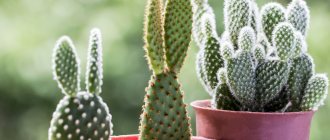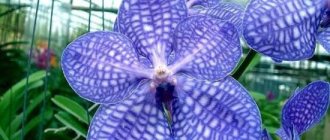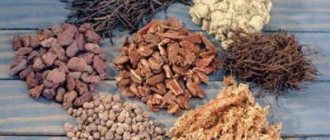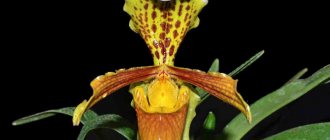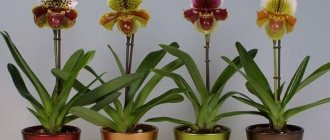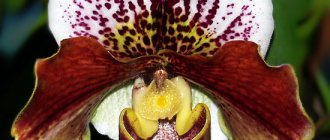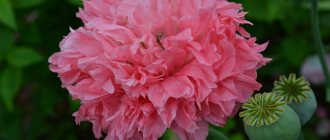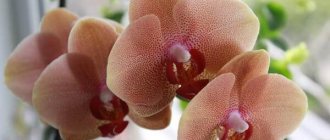Lady's slippers today are almost replaced from counters and window sills by hardy phalaenopsis. Luxuriously blooming, medium-sized and very variable, Paphiopedilums are orchids whose blooms you can admire endlessly. Nostalgic and fashionable at the same time, for many they remain unfamiliar plants, shrouded in myths and legends. In practice they are much friendlier than their royal reputation suggests. Paphiopedilums do not bloom without careful care, and the conditions for them are not standard, but they get used to living rooms well.
“Venus’s slippers”, or Paphiopedilum - a legend among indoor orchids
Paphiopedilum - description of the plant
The name Paphiopedilum, or Paphiopedilum, in contrast to the beautiful nickname “Venus’s slippers,” is not familiar to every gardener. The orchid, which received its name in honor of the ancient Roman goddess, was a legend long before its brothers became almost obligatory plants to grow, and a host of unpretentious hybrids made the dream of orchids come true for so many hobbyists.
Paphiopedilums (Paphiopedilum, official designation - Paph.) are terrestrial, sympodial, medium-sized orchids of the Cypripediaceae family. The maximum height of plants, taking into account the length of the peduncle, is only from 20 to 50 cm.
But paphiopedilums certainly cannot be called inconspicuous. Strongly shortened rhizomes and very strong, well-developed, fleshy roots are characteristic of all “Venus slippers.” They develop typically for sympodial orchids - the “rosette” blooms only once, releasing a peduncle and will not be able to bloom again.
The baton of fading plants is picked up by daughter plants, growing at the base of the mother rhizomes and replacing them. This plant is never grown as individual specimens, but only in families or groups of 3 rhizomes, constantly producing new offspring.
The strap-shaped leaves, typical of orchids, with strongly pointed tips and a central fold, look very neat and strict. The leaves can reach 60 cm in length, in some species they are limited to several times smaller in size. They are one-color, bright green or marble, sitting in a kind of double-sided rosette. The leaves of paphiopedilums grow quite actively, before dying and drying out they turn yellow and brown.
In paphiopedilums, before releasing the peduncle from the center of the rosette, a smaller signal or stop leaf develops, which seems to precede the beginning of the flowering period.
Paphiopedilum "Deperle" (Paphiopedilum delenatii x Paphiopedilum primulinum). © Eric Hunt
Flowering lady's slippers
Peduncles of paphiopedilums develop from the center of the rosettes. As a rule, they are quite straight and smooth, longer than the leaves.
They got their nickname “Venus’s slippers” for the swollen shape of their large lips, which really resembles elegant ladies’ shoes. It is the only orchid that has three types of "petals" per flower.
The upper sepal is rightly compared to a sail; it is very large, bright, with patterns, and slightly inclined to protect the lip. The upper sepal always differs from the two lateral ones in shape and size, and all of them are in no way similar to the lip in color. The patterns are contrasting and catchy. “Venus slippers” have three anthers at once - one sterile, similar to a shield, and two fruitful.
This is an orchid that blooms in spring. For her, flowering is considered natural during the growing daylight hours. But depending on the conditions and care, the flowering of paphiopedilums can shift indefinitely, be delayed or last for an unusually long time.
In fact, the flowering of this orchid always depends on the owners. In comfort, “Venus’s slippers” bloom twice a year, and revolving varieties bloom continuously for more than 2 years.
The color palette of Venus's slippers includes all known shades and halftones of all parts of the spectrum, except blue. White, yellow, pink, purple, violet, green, brown - the choice of shades and variations of combinations of most often multi-colored flowers is endless. And the beauty of the patterns - from tiny specks to spots, stripes and ripples - is amazingly diverse.
Description of the orchid
All Cypripedium species have relatively short, branching, rigid roots. Their stems come in different lengths - from 15 to 60 cm. The base is pubescent.
In the middle part there are 2-4 leaves measuring 6-16 cm by 3-12 cm. They are arranged in a spiral, alternately. The shape of the plates is elliptical, pointed. The edges are smooth and the surface is fleecy.
Most species produce only one bud, but there are some that produce up to three. They usually emit a very faint but pleasant sweetish odor. The size also differs - the diameter ranges from 30-70 mm. Perianths and petals are usually brown or burgundy. The lips are yellow, sometimes with crimson dots.
Paphiopedilum, on the contrary, has a well-developed root system and a short stem. Its leaves are belt-shaped, elongated, ranging in size from 50 mm to 0.6 m. They are connected into a double-sided rosette. In some species, the plates are rich green, in others they have patterns reminiscent of marble stains.
Representatives of the genus produce flower stalks (4-60 cm long), with the majority producing only one bud. There are, however, a few exceptions.
This is interesting: the undoubted record holder is Paphiopedilum victoria-regina (Paphiopedilum Queen Victoria). The plant is capable of consistently opening up to 30 flowers.
The buds are usually very large - up to 100 mm. There are a variety of shades - from yellow-orange to white-pink.
Groups and categories of lady's slippers
This orchid is rightfully recognized as the most diverse. And at the same time, all the “Venus slippers” are something special, but still stand out. They differ in the conditions and care they require, and many nuances of cultivation, but the key to identifying different groups and categories lies in their flowering. This is where we begin to determine what this orchid will need for full flowering in the house.
According to the characteristics of flowering, paphiopedilums are divided into three large groups - single-flowered, multi-flowered and continuously flowering varieties and species.
Pretty Paphiopedilum (Paphiopedilum conco-bellatulum). © Orchids by Hausermann
Two-flowered Paphiopedilum delenatii orchid. © Stefano
Paphiopedilum concolor. © SERGEI EREMIN
Single-flowered paphiopedilums
This is the largest group of species and varieties, including mainly “wild” or species plants, simple and complex hybrids of “Venus slippers”, from which plant breeding began.
In fact, this is a group of the oldest Paphiopedilums in cultivation. The name of the group clearly indicates the main feature of the plants - the production of very large, but only one, very rarely - two flowers on a peduncle, which after flowering can simply be cut off. The flowering period is quite long. Flowers can last up to 3 months.
Among the species in this group are:
- Paphiopedilum insigne is the most unpretentious of all types of lady's slippers. Its beige-light green flowers are fragrant and bloom in winter.
- Paphiopedilum conco-bellatulum is one of the most beautiful speckled orchids. Graceful snow-white flowers with almost black dots on all round petals seem like an artificially created miracle.
- Two-flowered Paphiopedilum delenatii orchid and its many decorative forms with delicate pink and white colors and very large round side petals.
- An exception to the “rules” of this group is Paphiopedilum concolor , which can produce three delicate pastel flowers with small black speckles on round petals.
- The first of the “Venus slippers” hybrids is the unpretentious golden-white, wavy and watercolor Paphiopedilum harrisianum – Paphiopedilum villosum x Paphiopedilum barbata.
But everyone still knows the single-flowered “Venus slippers” by their appearance and relative unpretentiousness of American complex hybrid varieties. Although they produce one flower, it is up to 20 cm in diameter and has very complex speckled patterns, larger side petals with a rounded wavy shape and contrasting colors. Maudiae' with a white upper petal .
Paphiopedilum harrisianum. © Aveter
Paphiopedilum rothschildianum. © Eric Hunt
Paphiopedilum parishii. ©OrChris
Multifloral paphiopedilums
This is a group with clusters of inflorescences in which up to 10 flowers are collected. These orchids bloom for as long as single-flowered ones - up to 3 months.
Among this group of “Venus slippers”, not only varietal orchids with bright colors are especially loved (the name often directly indicates the original type of orchid and color shade - 'Delenatii White' , 'Delenatii Pink' , 'Delenatii Gold' ), but also some others kinds:
- paphiopedilum "Deperle" (Paphiopedilum delenatii x Paphiopedilum primulinum) with elegant porcelain-white flowers with elongated petals;
- with thin side petals sticking out like mustaches, a red lip and a striped sail, rothschildianum ;
three species with long purple side petals hanging down in spirals to the leaves:
- striped yellow-white philippinense ;
- striped beige-brown-purple striped sanderianum ,
- white-green Paphiopedilum parishii.
Revolving or continuously flowering paphiopedilums
This is a group of tirelessly or sequentially flowering hybrid varieties in which, thanks to selection, up to 30 flowers bloom on peduncles to replace each other. At the top of these paphiopedilums there are always 1-2, sometimes 3, flowers in bloom.
The ability of each flower to last for more than a month allows the plant, even on one peduncle, to extend the flowering period for 2 years or more. The longer it continues, the more the peduncle lengthens and the smaller the flowers themselves are.
Without exception, all representatives of revolving paphiopedilum are hybrid plants obtained mainly by crossing Paphiopedilum glaucophyllum , Paphiopedilum liemianum, Paphiopedilum Victoria-regina and Paphiopedilum primulinum.
The most popular and “reliable” of the variety series of revolving lady’s slippers is considered to be the group of varieties “Pinocchio” with shortened, almost linear variegated lateral petals, a swollen lip and a feather-like large upper petal.
Paphiopedilum Pinocchio. © NjuTIKA
Growing conditions for indoor paphiopedilums
Heat-loving and cold-resistant, producing single flowers or inflorescences, paphiopedilums are so diverse that they simply do not have general growing rules. When purchasing even popular varieties of “Venus slippers”, it is worth clarifying all the nuances of care and growing conditions. After all, plants are so individual that there are simply no uniform standards for them. They require an individual approach.
Each Paphiopedilum orchid is special, and that is how it should be treated.
Lighting and placement
Unlike many beautifully flowering orchids, paphiopedilums adapt well to different lighting, especially if they are accustomed to new conditions gently and during a period of rest.
They can bloom in both bright light and light partial shade; they are content with any diffused light. And just like all orchids, they cannot tolerate either strong shading or direct sun. The latter is especially dangerous in combination with heat.
At the same time, multi-flowered paphiopedilums, especially species and not hybrid plants, require brighter lighting than single-flowered and revolving ones, and can bloom in autumn and winter only with strong artificial lighting.
Approximate lighting indicators that are comfortable for almost all types of paphiopedilum are from 2100 to 2600 lux and from 12 to 14 hours of daylight.
Venus's slippers are light-dependent and extend towards the light source. Outside the flowering period, they are regularly rotated to ensure uniform development of double-sided rosettes of leaves. But during the period of budding and flowering, plants cannot be moved.
The best place for paphiopedilums is rightfully considered to be eastern window sills or any places with a similar intensity of lighting - from diffuse lighting near southern or partially southern windows to artificial additional lighting in the interior.
Temperature and ventilation
"Venus's slippers" love the cool, they cannot stand any cold. no heat, and, like all orchids, they love daily temperature changes (especially revolving varieties). The optimal range of indicators for their cultivation depends on the heat-loving or cold-hardiness of the variety.
Most single- and multi-flowered “Venus slippers” of hybrid origin are cold-resistant and the ideal maintenance regime for them is a soft indoor one, from 14 at night to 20 during the day during the period of active growth from March to October, and from 12 to 18 degrees in winter.
The brighter the leaves of a variety, especially if they are decorated with specks, the more heat-loving orchids are. Like all revolving paphiopedilums, these varieties do not tolerate temperatures dropping below 18 degrees and will prefer to grow at temperatures from 18 to 22 degrees.
Their dormant period is short, immediately after flowering, it may not be cool, but it is better to limit the minimum temperature to 16 degrees.
Ventilation should be very careful, but regular. Plants can be moved to sheltered areas on the balcony or garden, as long as the lighting is controlled and protected from too much light. Paphiopedilums do not tolerate the proximity of heating systems and air conditioning devices.
Paphiopedilum philippinense. © Eric Hunt
Paphiopedilum care at home
Despite the difficulties in choosing a location and the requirements for conditions, lady’s slippers are one of the simplest and therefore special orchids in caring for. They will even be fine with regular watering, as long as the minimum requirements are met for all care items.
Watering and air humidity
Paphiopedilums require very abundant watering during the period of active growth. This is one of the most moisture-loving orchids. “Venus’s slippers” love light, constant soil moisture and do not survive complete drying out very well, and some varieties even die during drought.
The substrate should not remain damp; it is dried until slightly damp, but not completely, based on the change in color of the roots in transparent containers and the tactile (tactile, touch) sensations in ceramic pots. Excess water must be drained no later than 5 minutes after watering.
Paphiopedilums can be watered using the classic method rather than by immersion, although it is safer due to uniform wetting of the substrate.
The winter watering regime depends on the type of plant. Single- and multi-flowered paphiopedilums prefer to reduce watering by several times. Revolving paphiopedilums are watered carefully and equally, with the exception of light drying after the last flowers fade and before growth begins.
Watering “Venus’s slippers” has one key feature: these plants cannot tolerate heavy wetting of the above-ground parts and accumulation of water at the base of the leaves; you need to water carefully around the perimeter or without deepening the rosettes from below when soaking.
Paphiopedilums should be watered with rainwater or similar artificial filtered analogues. Many old varieties can withstand ordinary settled water, but it is better not to experiment with fashionable new products.
This orchid does not like very high humidity, preferring to grow in rooms with values from 30 to 60% (during the growth of leaves and daughter rosettes, it is desirable to increase the humidity to the upper norms). It can be sprayed with “fog” (warm water), especially in summer and in hot temperatures, and periodically wipe the leaves with a slightly damp sponge. Accumulation of dust on leaves is unacceptable
Top dressing and fertilizer composition
This orchid is fed all year round, with the exception of the dormant and flowering periods. The plant does not like sudden changes in the nutritional value of the substrate, so instead of periodic fertilizing, it is better to carry it out constantly, adding a small amount of fertilizer to the water for irrigation.
If you use the usual feeding scheme, then during the period of active growth fertilizers are applied once every 3 weeks; with constant feeding, the dose is divided by the number of waterings (by 3 with standard weekly watering).
For “Venus slippers” you can only use special fertilizers for orchids. This orchid cannot tolerate experiments with the composition of fertilizers or organic matter.
Trimming and shaping lady's slippers
These procedures boil down to removing dry flower stalks and leaves (as with all orchids, it is better not to rush the natural development processes).
Paphiopedilum insigne. ©John Varigos
Transplantation, containers and substrate
Lady's slippers are replanted only when there is simply no room left for the development of roots. Paphiopedilums prefer transplants no more often than after 2-3 years. But it is better to monitor the development and condition of the root system. Any signs of rot and mold, accumulation of salt crystals and other deposits are a signal for an emergency transplant.
For paphiopedilums, in years when a full transplant is not carried out or when the quality and structure of the substrate are preserved, a partial change of the substrate is permissible. It is carried out more often than transplants - every six months, carefully, trying not to come into contact with the roots and removing only the freely crumbling part of the soil and the top contaminated layer.
The optimal period for transplantation is spring, from late March to early May.
These orchids need typical specialized containers - orchid pots with numerous holes in the bottom and double containers, allowing all roots to breathe evenly and ensuring the maximum reduction in the risk of waterlogging of the substrate.
Paphiopedilums develop better in transparent containers, ceramic and glass, rather than plastic containers. Transparent containers allow you to freely observe the root system. They do not grow in regular containers for indoor plants and are not suitable for growing on blocks.
For paphiopedilums, use a standard orchid substrate. Complex soils are preferable to bark-only substrates. Acceptable additives are charcoal, perlite, coarse sand, coarse coconut soil, expanded clay.
Certain types of Paphiopedilum require careful monitoring of pH levels, but they usually grow well in slightly acidic and neutral soils. When purchasing a substrate, it is better to check whether the list of recommended species includes “Venus slippers”.
After transplantation, the plants are not watered, only increasing the air humidity for them to 60-70% and controlling the temperature at about 20-21 degrees. The first watering is carried out after 5-8 days.
Replanting paphiopedilum orchids
How to divide a paphiopedilum bush photo
Replant at intervals of 2-4 years, focusing on the size of the bush (if the orchid’s shoe has become crowded) and the condition of the substrate (when it has oxidized, compacted or become loose). Carry out the procedure in the spring, when the plant is not yet blooming.
Lady's slipper orchid transplant photo
For planting, choose plastic or ceramic pots that widen towards the top - this makes it easier to remove the orchid when replanting in order to protect the roots from damage.
How to propagate paphiopedilum orchid by dividing the bush photo
The soil requires a neutral or slightly acidic reaction. You can prepare a mixture based on the bark of coniferous trees (5 parts) with the addition of one part each of charcoal and peat. Another option: 2 parts conifer bark, 1 part peat and a little dolomite flour.
Lady's slipper orchid bushes after transplantation photo
After replanting, the orchid can be lightly watered with a weak solution of fungicide to prevent the development of diseases due to damage to the roots during replanting.
Diseases, pests and problems in growing paphiopedilums
This orchid is extremely sensitive to cold and improper care. Paphiopedilums drop their buds and may stop flowering if they are too humidified and in too low temperatures.
"Venus's slippers" often signal problems with the substrate by changes in the leaves. If the leaves turn brown without yellowing, the blackness spreads from the top in a kind of border, the plant signals that the substrate is over-salted or affected by fungal diseases.
Among the diseases on the plant, botrytis is often encountered, causing damage to flowers and their falling off, as well as all types of rot and fungal infections of the roots. Any disease should be dealt with immediately by emergency replanting and fungicides; in case of severe damage, by removing damaged areas of roots and radically pruning the plants.
Occasionally, these orchids become infected with scale insects, mealybugs, and spider mites.
Adult bushes of “Venus slippers” are divided when they grow too large or when there is a desire to increase the collection. © Karma Forester
Diseases and pests of Paphiopedilum
Why do the leaves turn yellow?
An indicator of the condition of a plant is its leaves. If the leaf blades are wrinkled, it makes sense to sound the alarm. When a plant does not receive enough moisture and nutrients, the necessary forces begin to “extract” from the leaves, you should immediately check the root system.
Carefully remove the plant from the substrate; normally the roots are light brown or brown in color; they may have barely noticeable short fibers. Pull the velamen (top protective layer) slightly; if the roots resemble wires, the plant dies. Trim dry roots (also remove wilted leaves), treat cut areas with a fungicide, replant in a new substrate, provide regular watering and a high level of air humidity. This will allow you to reanimate the root system.
Why do leaves become spotted?
Excessive watering may cause rotting of the root system. Brownish spots will appear on the stems and leaves. An emergency transplant will also be required, with removal of the affected areas, treatment with a fungicide and replacement of the substrate, and then adjust the watering.
Paphiopedilum lady's slipper orchid can suffer from the following pests:
- Spider mite - leaves thin cobwebs on the leaf plates, the leaves curl and dry;
- Scale insects - they can be recognized by dense “growths” on the leaves - these are insects;
- Scale insects - cause damage to leaves and inflorescences, leave sticky secretions (whitish coating) on the plant, and can cause the development of diseases.
If pests are found, moisten a cotton pad with an alcohol solution and remove them mechanically, then rinse the plant with warm water (40 ° C). If the pests remain, treatment with special preparations will be required: use acaricides against spider mites, and insecticides against the rest.
